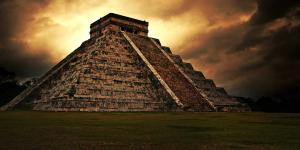You are here
Book of Mormon Central is in the process of migrating to our new Scripture Central website.
We ask for your patience during this transition. Over the coming weeks, all pages of bookofmormoncentral.org will be redirected to their corresponding page on scripturecentral.org, resulting in minimal disruption.
Gospel Doctrine Lesson #22: Have Ye Received His Image in Your Countenances?

Scripture Block
Alma 5-7
Alma the Younger taught the people to let their hearts changed by God, be pure, and strip themselves of pride and envy. Getting into the details of these chapters yields meaningful rewards.
Lesson Manual
KnoWhys
Featured Visuals
"Chart 5-62: 50 Questions of Alma 5: Questions 1–17," by John W. Welch and Gregory Welch, Charting the Book of Mormon
This chart groups Alma's first seventeen questions by themes: Remembering God; Knowing the essential logic of the gospel; and being personally converted.
"Chart 5-63: 50 Questions of Alma 5: Questions 18–29," by John W. Welch and Gregory Welch, Charting the Book of Mormon
This chart lists Alma's questions 18–29 under the theme of Imagining the judgment day, showing that there are ultimately only two possible outcomes at the final judgment: eternal joy or eternal remorse.
"Chart 5-64: 50 Questions of Alma 5: Questions 30–40," by John W. Welch and Gregory Welch, Charting the Book of Mormon
Alma's next questions, Alma asks hearers to assess their own spiritual conditions, to identify with the fold of God, and to gain spiritual knowledge.
"Chart 5-65: 50 Questions of Alma 5: Questions 41–50," by John W. Welch and Gregory Welch, Charting the Book of Mormon
The last ten rhetorical questions that Alma asks concern refusing to repent of sins.
Video: Discussions on the Book of Mormon: Alma 5-7. Available at BYUtv.org
Professors from the BYU Department of Ancient Scripture discuss the beginning of Alma's reform of Zarahemla, as he resigns from the judgment seat and focuses on his responsibilities as the High Priest of the Church.
Articles
Alma 5
"To Sing the Song of Redeeming Love(link is external)," by Robert A. Rees, The Reader's Book of Mormon: To Sing the Song of Redeeming Love: Alma 1-19(link is external)
Rees tells a personal story of love for Alma's message, from his own seed of faith through his mission. He sees the book of Alma as a microcosm of the great conflict between good and evil.
"Alma 5: The Song of Redeeming Love(link is external)," by LeGrand L. Baker and Stephen D. Ricks, Who Shall Ascend Into the Hill of the Lord? The Psalms in Israel's Temple Worship in the Old Testament and in the Book of Mormon(link is external)
Baker and Ricks explore Alma's sermon in context of the biblical Psalms and ancient Temple ritual. Alma's reference to the "song of redeeming love" likely refers to a particular psalm that would be sung accompanying temple rituals. The article also suggests that having the image of God engraven on one's countenance may be a reference to being clothed in sacred vestments for temple worship.
"The Way of Life and Death in the Book of Mormon(link is external)," by Mack C. Sterling, Journal of Book of Mormon Studies 6, no. 2 (1997)(link is external)
Nine Book of Mormon texts are examined in detail for their teachings on the choice people have between walking with Christ or hearkening to the devil. An understanding of this paradigm is critical, both in order to assimilate the essential message of the Book of Mormon on life and death and to understand its theological relationship to the Doctrine and Covenants.
"Why Does Abinadi Use the Phrase 'Bands of Death'? (Mosiah 15:8)(link is external)," by Book of Mormon Central KnoWhy 93 (May 5, 2016)(link is external)
In Alma 5, Alma uses the phrase "Bands of Death." This essay examines the history and meaning of this rare phrase.
"Alma the Younger's Seminal Sermon at Zarahemla(link is external)," by Robert A. Rees, Bountiful Harvest(link is external)
Alma the Younger's sermon in Alma 5 uses a variety of literary devices to create a rich and masterful sermon, and Alma 5 draws on the whole of Book of Mormon history to create the point.
"A Mighty Change,"(link is external) by C. Max Caldwell, The Book of Mormon: Alma, The Testimony of the Word(link is external)
This chapter shows that Alma's hope for salvation is based on four conditions: follow the living prophet, have a mighty change of heart, trust in God, and endure to the end.
"'Stretch Forth Thy Hand and Prophesy': Hand Gestures in the Book of Mormon(link is external)," by David Calabro, Journal of Book of Mormon Studies 21, no. 1 (2012)(link is external)
Alma 5 describes "the arms of mercy" extended to all people. Hand and arm gestures are often used to convey meanings that complement the verbal lessons being taught.
"Antithetical Parallelisms in the Book of Mormon(link is external)," by Donald W. Parry, Reexploring the Book of Mormon(link is external)
Alma 5:40 employs a literary device in Hebrew known as an antithetical parallelism. The device adds meaning to the message of Alma 5.
"Repentance: A Mighty Change of Heart(link is external)," by Brent W. Webb, BYU Speeches May 18, 1999(link is external)
Webb tells of a friend’s heart transplant: the young man underwent a physical change of heart and was spared from premature death. Alma preached of our need for a symbolic change of heart, with the certain safety from spiritual death.
Alma 6
"Dealing with Opposition to the Church(link is external)," by Rex C. Reeve Jr., The Book of Mormon: Alma, The Testimony of the Word(link is external)
Rex Reeve explores the internal and external issues the Nephite church faced at the beginning of Alma. Between non-believers and apostasy within the church, Alma had to focus his efforts on missionary work within and without the Church.
"The Cultural Context of Nephite Apostasy(link is external)," by Mark C. Wright and Brant A. Gardner, Interpreter: A Journal of Mormon Scripture 1 (2012)(link is external)
Nephite apostates turned away from true worship in consistent and predictable ways throughout the Book of Mormon. A Mesoamerican setting provides a plausible cultural background that explains why Nephite apostasy took the particular form it did.
Alma 7
"Straightening Things Out: The Use of Strait and Straight in the Book of Mormon(link is external)," by Paul Y. Hoskisson, Journal of Book of Mormon Studies(link is external) 12, no. 2 (2003(link is external))
Alma 7 uses "paths" as a metaphor in several ways to discuss the way to eternal life. Confusion between the use of strait and straight existed in Joseph Smith's day and continues to persist today. This confusion is manifest in the spelling of the term in the original manuscript (strait preserved in 10 of 11 existing occurrences), the printer's manuscript (all 27 instances spelled strait), and the 1830 edition (in which the compositor changed all 27 instances to straight). Through close examination of meanings, comparison to Hebrew words and usage, and analysis of poetic form, Hoskisson examines each instance of strai(gh)t in the Book of Mormon and recommends a spelling for each one.
"The Land of Jerusalem: The Place of Jesus' Birth(link is external)," by Robert F. Smith, Reexploring the Book of Mormon(link is external)
"Jerusalem" in Alma 7 refers to the larger geographic region of Zion, not only the city proper.
"Revisiting the Land of Jerusalem(link is external)," by John W. Welch, Pressing Forward with the Book of Mormon(link is external)
The Dead Sea Scrolls refer to the land of Jerusalem in the same manner that Alma 7:10 does.
"I Have a Question: Why does the Book of Mormon say that Jesus would be born in Jerusalem?(link is external)" by D. Kelly Ogden, Ensign (August 1984)(link is external)
Alma 7:10's reference to the land of Jerusalem is not erroneous but uses known biblical figures of speech.
"Notes and Communications: Knowledge of Christ to Come(link is external)," by John A. Tvedtnes, Journal of Book of Mormon Studies 5, no. 1 (1996)(link is external)
Prophetic references to Christ appear not only in the Book of Mormon but also in other ancient Christian works.
"Notes and Communications: Cities and Lands in the Book of Mormon(link is external)," by John A. Tvedtnes, Journal of Book of Mormon Studies 4, no. 2 (1995)(link is external)
The practice of naming lands by a chief city of the land correlates well with authentic Old World practices.




